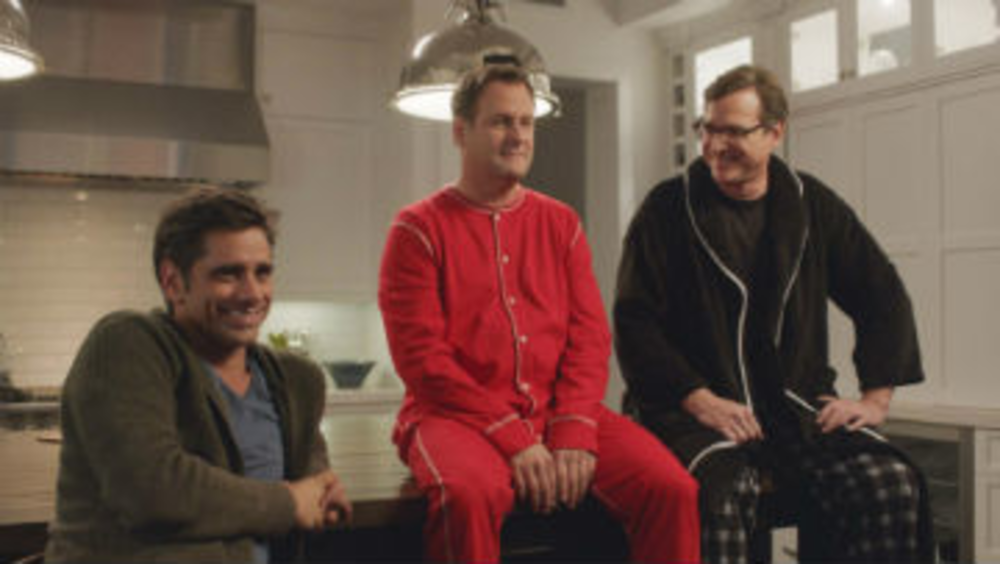I’ve only been alive for two full decades. But I have to say, I strongly prefer the first. The 1990s were a blissful time. There was great fashion (just look at my stylish turtleneck in the picture below); amazing music (Backstreet Boys Millennium was my first CD); and awesome television. And when my brother and I weren’t tuning into Doug or Rugrats, we were watching Full House (listen to the epic theme song here).
For those deprived of 1990s pop culture, Full House is about a single dad, Danny Tanner (played by Bob Saget), who moves in his two best friends, Jesse (John Stamos) and Joey (Dave Coulier), to help him raise his three daughters. My brother and I used to tape episodes onto VHS, and I’d wish that a hot Uncle Jesse or a goofy Joey would move into our house.
So, when Dannon Oikos Greek Yogurt announced that it was reuniting the trio for its Super Bowl commercial, I couldn’t help but feel giddy.
“This is meant to be a very and entertaining spot,” says Lexie Leyman, communications and community affairs associate for The Dannon Company. “Our community will be able to laugh, have fun, and engage in a way that has not traditionally been focused on for better-for-you snacks.”
Oikos launched a Super Bowl teaser on January 20 and ran the sneak-peak on the brand’s YouTube channel and campaign site: oikosbromance.com. So far, the teaser has accumulated more than 1.26 million YouTube views. Michael Neuwirth, senior director of public relations for The Dannon Company, says that the teaser also achieved a like-to-dislike ratio of more than nine to one. Five days later Oikos released its official Game Day commercial on YouTube, which now has more than 2.28 million YouTube views.
Oikos’s decision to debut the spot on YouTube prior to Sunday’s game was fueled by competition for consumers’ attention, Neuwirth says. Although he admits that competing for attention is a challenge for Super Bowl marketers, he says that it also inspires them to deliver highly creative messages in a short period of time.
“We launched our Super Bowl ad on YouTube [and] that’s not something that a traditional marketer would normally do,” Neuwirth says. “But we chose that route because of the scale that YouTube affords leading up to the game. We wanted to break through loud and early.”
However, the TV commercial isn’t the only ingredient in Oikos’s Super Bowl mix. In fact, the Greek yogurt brand whipped up an entire multichannel campaign. For instance, to demonstrate how Greek yogurt can fit into the traditionally unhealthy Super Bowl spread, the brand provided recipes on oikosbromance.com. Oikos also posted behind-the-scenes videos of Saget, Coulier, and Stamos on the site that feature the campaign’s hashtags #fuelyourpleasure and #oikosbromance. This multichannel approach, Leyman says, is critical to driving engagement both before and during the Super Bowl.
“Part of the fun about the Super Bowl is that you have the opportunity to engage weeks before the actual event,” Leyman says. “It’s a chance for us to really spread our reach to different consumers.… Not every consumer may be watching the Big Game on Sunday, but they may be tuned into social media and different channels. It’s also a way for us to engage in different channels and bring some awareness outside of just the Big Game.”
After the Super Bowl, Oikos plans on driving sampling trucks across the country to give consumers the opportunity to try the yogurt featured in the ads, Neuwirth adds.
This is Oikos’s second Super Bowl appearance. The brand made its first Super Bowl debut in 2012, and Neuwirth says that the company is going into this year’s event with a more agile game plan.
“We went into 2012 with a pretty clear idea of what our plan would be from the very early stages,” he says. “In the process of the execution in 2012, we made a lot of adjustments…. Part of our thinking for the 2014 plan is to have a clear idea of where we want to land, but to maintain flexibility in how we get there. It’s made us more nimble in our decision making.”
Oikos isn’t the only brand to use nostalgia to its advantage. Last year Internet Explorer, through “Child of the 90s,” showed the maturation of the company and trends by featuring major 1990s fads in its ad.The spot has accumulated nearly 48.6 million YouTube views to date. Similarly, Samsung showed clips of iconic characters using its smart watches—including 1990s live action heroes the Mighty Morphin Power Rangers—for the launch of its Galaxy Gear this past October. This spot has earned more than 3.5 million YouTube views to date.
Jonathan Perelman, VP of agency strategy and industry development at BuzzFeed, says tapping into nostalgic sentiments can help brands relate to their consumers on an emotional level.
“As humans, we love to look back at times gone by. We love being brought back to the foods we love, shows we watched and grew up on, and other shared experiences,” he says. “It’s part of being human. Add a favorite brand into the mix, it heightens the experience and emotional connection that we have.”
However, brands must understand the context of wistful references if they hope to leverage them successfully, Perelman says. And taking consumers down memory lane helps marketers expand their reach. For instance, when consumers relate to a brand’s memory, they’re likely to share that memory with those in their social tribes who can also relate, Perelman notes.
“You can never force it,” he says. “To do it well, a brand needs to understand the cultural place that they occupy.”
So whether you embraced the Beanie Babies era or couldn’t wait for the days of the scrunchie to end, knowing how to leverage consumer emotions through memories is one marketing tactic that will live on for decades.








